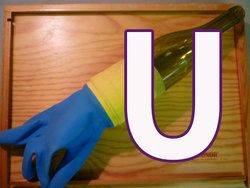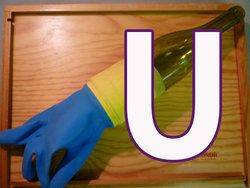 is for Udderbot. And at this moment I am 97% confident that you are wondering just what in tarnation an udderbot is. Good question. Take a look; it’s a bottle with rubber glove attached at the bottom. Bottle-udder-bottom.
is for Udderbot. And at this moment I am 97% confident that you are wondering just what in tarnation an udderbot is. Good question. Take a look; it’s a bottle with rubber glove attached at the bottom. Bottle-udder-bottom.
You may also be wondering — so what? And so — I invite you to join me for one of those unexpected journeys in Champaign-Urbana where the odd connection opens a door to Something Completely Different.
The udderbot is an original, surprisingly facile musical instrument, alive and well in Urbana. The principle is probably familiar to you, if like me, as a child you tried to make music with any convenient tool: a blade of grass, my cupped hands, the rim of a coke bottle. I don’t know how universal this inclination is; in any case, my brother and sister and I considered it a point of pride to master the art of pursing our lips at just the right angle to get a tone out of a coke bottle. As we worked on our technique, we discovered that different levels of coke in the bottle change the pitch.
This is the principle of the udderbot. Put water in the rubber glove, hold it just right, blow, and you can adjust the level of the water in the bottle to produce an infinity of tones.
And now let me introduce Urbana resident, composer, teacher and udderbot virtuoso Jacob Barton.
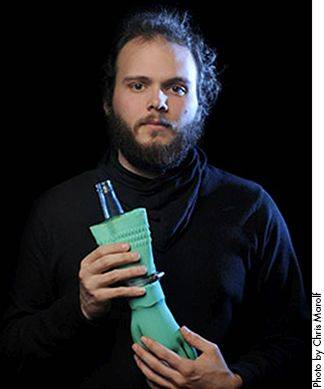
I was fortunate to attend The First World’s All-Udderbot Concert at the Independent Media Center in August 2010, masterminded and orchestrated by Barton, co-inventor of the udderbot. I expected whimsy and found more; the music was complex and beautiful, the skill and engagement of the musicians impressive.
A novel instrument calls for novel composition, and the audience was treated to pieces ranging from “Udderbotsicle” by Aaron K. Johnson to new works by local musicians Barton, Paul Kotheimer and Andrew Heathwaite, composed for udderbot and oboe, violin, guitar, otonal dulcimer, drums, viola, cello, and bass. It was spellbinding.
I think you’ll agree; here you’ll find some samples of udderbot composition and performance.
Recording of All-Udderbot concert
I wanted to know more; and so I went to the source.
In the summer of 2005, Barton participated in a program in music composition at Gesundheit Institute, the West Virginia campus of Patch Adams and The School for Designing a Society, a long-time Urbana institution. Recycling was spotty, and Barton was aware that in one month 120 empty bottles accumulated, begging to be repurposed. He had been wanting to inspire some kind of music ensemble, and over the years has designed and built an impressive array of original instruments. So he put his mind to the challenge.
And here we move onward and upward from the coke bottle precursor. Barton jumped deep into both engineering and musical application, looking for ways to alter a bottle tone at will. He cut the bottoms off the bottles and experimented with raising and lowering them in water – for one performance, in the middle of a lake – while blowing on the rim to produce different pitches. In these developmental days he called the instruments “slide bottles.”
Before his graduation in 2007 with a degree in music composition from Rice University, Barton continued to develop his musical bottle scheme. An accompanying horn player, Matt Gray, came up with the idea of attaching a rubber glove filled with water to the open end, and thus introduced variable-level liquid in a closed system, and a whole new musical mechanism entered the scene. The name udderbot was bestowed by an ensemble conductor at Rice.
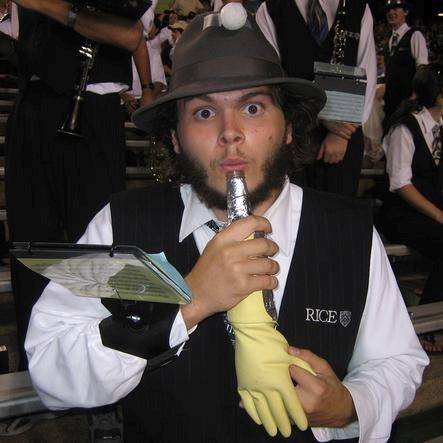
The udderbot is more than a musical amusement in Barton’s world. At Rice, he was awarded a BMI Student Composer Award for “Xenharmonic Variations on a Theme by Mozart.” A pivotal aspect of Barton’s work, microtonal composition, questions the canon of the western 12-note scale. Microtonal scales expand the defined notes within an octave to 19, 23, 31, even as high as 72. The term xenharmonic was coined by Ivor Darreg, a seminal American composer and theorist, considered an outsider in the music world, as a combination of two Greek words: xenia, “hospitable” and xenos, “foreign.” Most western ears would agree with the “foreign” side of it; they perceive as dissonance tones that fall between the customary “12-tone-equal-temperament” pitches in an octave.
Barton tells me that this 12-tone scale took on the semblance of inevitability only when the piano steel frame was introduced in the early 1900s with its “equal tempered” tones. Each semitone of the piano is equally distant from the adjacent tones, in the amount of 100 “cents,” the measurement used for musical intervals. The human ear can distinguish far closer tones, the capacity that microtonal scales exploit.
The udderbot offers freedom in defining the distance between notes. And so it lends itself perfectly to microtonal composition.
To make microtonal theories and experiments more accessible, Barton has just published The Sagittal Songbook, a collection of microtonal songs and lyrics by a number of composers. This innovative volume answers the challenge of providing a system of notation that is capable of representing smaller intervals than the traditional notes on a five-line staff. Here is a detail from Barton’s composition, “The Alphabet Song”, appropriate for this abecedarian audience, which is composed in a scale of 31 notes to the octave as represented by the symbols shown below it.
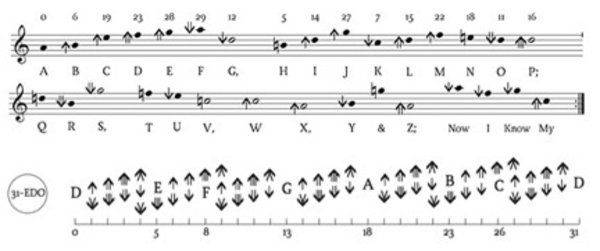
In Urbana-Champaign, the Music Department at the U of I has its own history of introducing alternatives to musical conventions. The Experimental Music Studio, the first recognized electro-acoustic studio in the United States, was established in 1958 in a small attic across from Smith Hall by Lejaren Hiller, who came to the U of I as a professor of chemistry and later chose to transfer to the faculty of music. Hiller admired the work of Herbert Brün, then in Munich, who was fascinated by the radio equipment available after World War II and used it to experiment in producing music with computers, specifically for the theatre. Hiller invited Brün to join the studio, which also welcomed John Cage as collaborator and a remarkable group of musical innovators as well as remarkable electronic instruments such as the theremin.
And here we come full circle, with Herbert Brün’s arrival in Urbana. His work at the university in experimental composition and cybernetics led to the founding of The School for Designing a Society in 1993, organized around principles of experimental composition and consequences for proposing alternatives to the existing social and political order. The work of the school has attracted numerous experimental composers from all over the country. Barton moved to Urbana in 2007 to expand his work with the School.
Since then Barton has enriched Champaign-Urbana with the occasional Udderbot Marching Choir and ODDMUSIC Champaign-Urbana, a musical instrument library and music-makers’ cooperative last resident at the Independent Media Center. He is a musical activist who doesn’t hesitate to question at the same time the prevailing social and political orders.
If you’re interested in learning udderbot construction, technique, and composition, Barton has taught classes. Among his offerings are a wide range of courses, including Microtonality and You. I recently joined in a group sing from The Sagittal Songbook and experienced first-hand the challenges of finding the “right” pitch in a microtonal scale. Humbling and inspiring.

These are the ingredients for an udderbot-making workshop conducted by Barton at America’s Visionary Art Museum in Baltimore.
Yes, this community fascinates and entertains. There’s always something new to learn, some personality that opens a door abruptly into experiences that will expand your envelope. Keep your ears alert for strains of the udderbot in town. Perhaps Barton will revive the Udderbot Marching Choir when the polar vortex has gone into summer hiatus.
And on to the letter U. From my research, our contemporary letter has roots going back as far as 2000 BCE to the Phoenician character representing a tent peg or hook, shown something like this:  .
.
This evolved through numerous forms, meanings, and pronunciations through Aramaic, Canaanite, Hebrew, and into the Greek upsilon. In the Roman alphabet, U and V could be interchangeable, depending on position in the word. You may have noticed spellings on Latin inscriptions or English inscriptions such as “vpon” or “saue.” With the development of print, letterforms slowly became standardized, and U and V assumed their separate identities and usage.
The archive of abecedarian C-U lives here:
A B C D E F G H I J K L M N O P Q R S T U V W X Y Z








